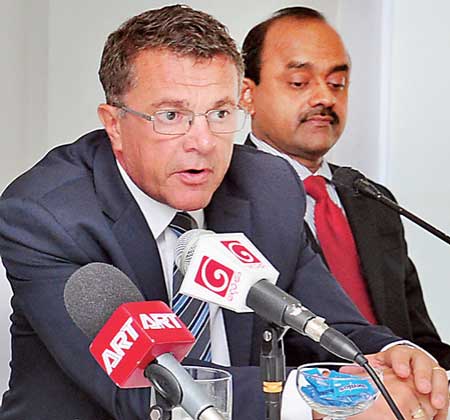Tuesday Oct 07, 2025
Tuesday Oct 07, 2025
Wednesday, 28 February 2018 00:00 - - {{hitsCtrl.values.hits}}

By Charumini de Silva
Sri Lanka’s high-end residential sector will face a challenging time ahead amid the oversupply in the market, Jones Lang Lasalle (JLL), which specialises in real estate, said, while playing down any fears of a bubble, insisting that hospitality, commercial office and retail is set for a good year.
“The high-end residential sector is in for a challenging year due to the oversupply. Rise in land prices, 15% VAT imposition, high material cost, shortage of labour and oversupply are key concerns of the market stakeholders. However, there is opportunity for hospitality, commercial office and retail sectors,” JLL Sri Lanka Managing Director Steve Mayes told Daily FT.
He said the only mechanism developers could adopt to overcome the challenging year in the high-end condominium segment was to slow down construction and let the demand catch up with the supply.
“New constructions will be stalled. Developers will slow down to allow demand to catch up with supply. I think they should focus on the low and medium income sector which still has room for growth. There will be zero growth in office because nothing will be delivered in 2018 and the first one to come is Shangri-La which is due next year,” he pointed out.
Mayes went on to say that new launches such as ITC, Krrish, and Tata Housing would help continue growth in supply, but it would be a slower growth than in 2017.
When asked about Sri Lanka’s rank in the Global Real Estate Transparency Index last year, he said the country had slipped several notches from 69th rank. “It has dropped a couple of places on the Transparency Index from the 69th rank in 2016. It is not a fundamental indicator, it is just a tool.”
As an overwhelming majority of luxury condominiums are limited to the Colombo Business District (CBD), Mayes said there was opportunity for the sector to grow in other parts of the country in the same manner, but it would solely depend on infrastructure development of other districts.
“Sri Lanka has always been one host town and that’s Colombo. The future of this country depends on infrastructure such as new airports, roads, railways and power supply. The coastal belt from Galle to Matara in the Southern Province has now taken off due to the development in infrastructure in those areas. There is opportunity for growth in Kandy and Jaffna as well as in Trincomalee, but it will not be viable and sustainable until the infrastructure is in place because people are not going to invest in a big way without them,” he added.
Highlighting that infrastructure depends on Foreign Direct Investment (FDI), he insisted that Government needed to ensure transparency and consistency in policy going forward.
“Clarity and consistency in policy has always been demanded by the stakeholders in the market. The Government needs to open up and say ‘bring your FDIs and build the infrastructure for us’ because 80% GDP goes for servicing debt and that’s not sustainable. Then the Government has got no money to do what it needs to do and they have to rely on foreign investments,” Mayes said.
He said the actual bank lending to the property sector is around 40% of their loan books, which is low compared regionally. In 2017 characterised by Central Bank concerns over a potential bubble being inflated and bank lending exposure to the real estate sector, feeding through to market sentiment and a muted performance overall.
“The challenge of the unknown is how much lending to the SME sector has been diverted into the real estate sector. There is suspicion from the Central Bank that some of the SME lending has been filtered into the real estate sector, but there is no evidence to prove this.”